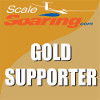Link to Peter Goldsmith Designs Web Page:

On Tuesday, January 9th, we made the 9 hour drive out to Monticello, Illinois to visit with Peter Goldsmith. He had finished drawing the plans for the 40% Schweizer 1-26E and was in the process of cutting the first set of parts for a test build. He has given me the honor of doing the first build of the first kit and to develop the instruction manual.
This build thread will be the draft copy of that manual and you are going to participate by helping me keep these instructions clear and on track!
Peter has already completed his fuselage, fin/rudder, and stab/elevator and made adjustments to parts as needed. My kit is the second run with those revisions made. He has not yet built the wings, so i may be ahead of him on this phase (at least for a day or two) and the parts are the first run.
The wings are ingeniously simple in design which translates into easy to build!
Wings are fully sheeted with 1/32" plywood. The kit includes 8 sheets measuring 24" x 48" in size. Basically, two of these sheets need to be joined to make a 24" x 96" sheet. The spar and ribs can then be positioned over this sheet so that it can be cut to size before gluing things in place.
First step for me was figuring out an easy way to make a scarf joint for these sheets. A trip to the home improvement store provided inspiration and we decided to try the following. Using a piece 1/8" thick aluminum strap and a sanding bar with half a strip of sandpaper, the sanding angle makes a nice 1/4" taper without too much effort.



On Tuesday, January 9th, we made the 9 hour drive out to Monticello, Illinois to visit with Peter Goldsmith. He had finished drawing the plans for the 40% Schweizer 1-26E and was in the process of cutting the first set of parts for a test build. He has given me the honor of doing the first build of the first kit and to develop the instruction manual.
This build thread will be the draft copy of that manual and you are going to participate by helping me keep these instructions clear and on track!
Peter has already completed his fuselage, fin/rudder, and stab/elevator and made adjustments to parts as needed. My kit is the second run with those revisions made. He has not yet built the wings, so i may be ahead of him on this phase (at least for a day or two) and the parts are the first run.
The wings are ingeniously simple in design which translates into easy to build!
Wings are fully sheeted with 1/32" plywood. The kit includes 8 sheets measuring 24" x 48" in size. Basically, two of these sheets need to be joined to make a 24" x 96" sheet. The spar and ribs can then be positioned over this sheet so that it can be cut to size before gluing things in place.
First step for me was figuring out an easy way to make a scarf joint for these sheets. A trip to the home improvement store provided inspiration and we decided to try the following. Using a piece 1/8" thick aluminum strap and a sanding bar with half a strip of sandpaper, the sanding angle makes a nice 1/4" taper without too much effort.




 ​
​
Comment